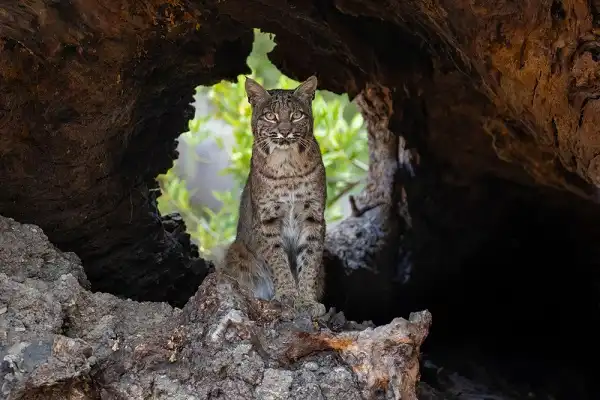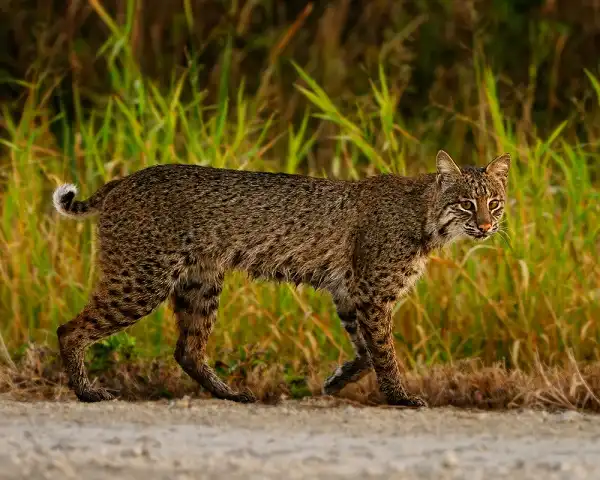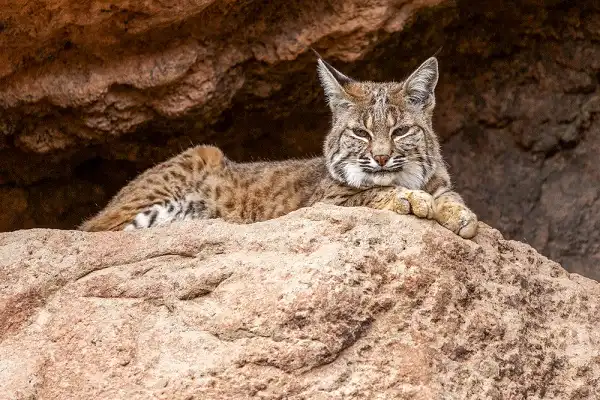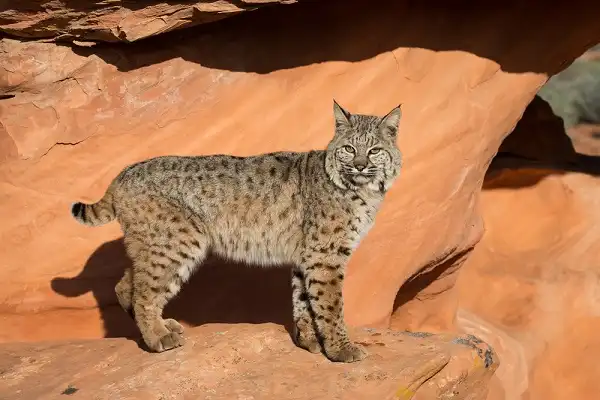The great bobcat is one of the most efficient and successful predators in North America. Known for its sharp eyesight, remarkable agility, and formidable hunting skills, this wild animal is a sight to behold as it silently prowls through various habitats in search of food. Despite their mystical aura and numerous predator traits, there is still much more to learn about these unique cats’ behavior and biology. Join us on our journey into understanding the amazing anatomy of the Bobcat – from their sense organs to predation strategies!

Bobcat Description
Bobcats, scientifically known as Lynx rufus, are medium-sized cats that are slightly larger than domestic cats, with males typically larger than females. They possess a sturdy, muscular build and feature distinct, tufted ears and a ruffed face. Their coat varies in color, typically ranging from light gray to brown, and is often spotted or striped – a natural camouflage that aids their stealth in the wild. A characteristic feature of the bobcat is its short (“bobbed”) tail, from which it derives its name. This tail, has a black tip and white underside, providing a unique identifier for this species. A bobcat’s legs are long and strong, enabling it to run at high speeds and deliver powerful leaps to capture prey.
Bobcat Habitat
Bobcats inhabit a wide range of environments across North America, demonstrating remarkable adaptability. They are found in diverse locales, from forests and mountains to semi-deserts and even in the fringes of urban areas. As solitary animals, they establish and maintain well-defined territories, marked with their scent, that can range from 1 to 18 square miles, depending on the availability of food and mates. While bobcats are perfectly adapted for a solitary, territorial lifestyle, human intrusion, and habitat fragmentation pose significant challenges. Urban development infringes upon their territories, forcing them into smaller and disjointed areas. However, interestingly, bobcats have shown resilience in adapting to these changes, often managing to survive in suburban areas by hunting small pets and livestock. Their adaptability and resilience are key to their survival amidst the rapidly changing landscapes of North America.
Bobcat Diet
Bobcats are obligate carnivores, which means meat is the essence of their diet. They demonstrate flexibility and adaptability when it comes to their prey items, which varies based on geographic location and time of the year. Primary staples in their diet include rabbits and hares, small rodents like mice and squirrels, and even birds. However, bobcats are opportunistic hunters and have been known to take down larger prey like deer, especially in colder months when small prey is scarce. Despite their hunting prowess, bobcats are not above scavenging and will consume carrion when necessary. This behavior usually occurs during periods of food scarcity, such as in harsh winters. To mitigate the risk of food scarcity, bobcats often cache, or store, their kills in secluded locations like under logs or fallen leaves. They cover the remnants of their meals with debris, returning to feed on it over several days, thereby reducing waste and maximizing their energy efficiency.

Bobcat Size
Bobcats are considered medium-sized among the wild cat species. On average, adult males weigh between 20 to 30 pounds and measure from 34 to 40 inches in length, including the tail. Female bobcats, generally smaller than their male counterparts, weigh between 15 to 20 pounds and have a length ranging from 28 to 34 inches. However, the size of bobcats can significantly vary depending on their geographical location, with those found in northern regions generally larger than those in southern regions. The bobcat’s body structure is robust and well-proportioned. Their muscular build is particularly evident in their hind legs, which are noticeably longer than their front legs. This physical attribute enables them to execute powerful leaps and quick sprints when hunting or evading threats. Bobcats also possess large, padded paws that aid in the silent stalking of prey and efficient navigation of varying terrains. The size of their paws is relatively larger compared to other felines of similar size, providing them with better stability and grip.
Bobcat Lifespan
Bobcats, like most wild felines, have a lifespan that is greatly affected by environmental factors and human intervention. In natural settings, without human interference, bobcats have been known to live up to 12 to 13 years. However, this is exceptionally rare, and the average lifespan in the wild is usually between 7 to 10 years. The leading causes of mortality among bobcats in the wild include disease, starvation, harsh weather conditions, and fights with other bobcats or larger predators. In captivity, bobcats tend to have a significantly longer lifespan, with some living up to 20 years or more. The controlled environment of a zoo or wildlife sanctuary provides bobcats with regular meals, medical care, and protection from larger predators and harsh weather conditions.
Bobcat Behavior
Bobcats exhibit a range of behaviors that highlight their adaptability and survival instincts. Known to be solitary and territorial animals, they mark their territories with scent markings and are most active during twilight hours, exhibiting crepuscular behavior. They are excellent climbers and swimmers, often using these skills to hunt or avoid predators. Communication among bobcats involves a variety of vocalizations, body language, and scent marking. When it comes to reproduction, bobcats usually mate in the late winter, and after a gestation period of approximately 60 days, a litter of one to six kittens is born. The mother raises the kittens alone, teaching them essential survival skills before they disperse to establish their territories. This solitary and adaptable behavior has allowed bobcats to survive in diverse habitats across North America, showcasing their resilience amidst changing environments.

Bobcat Speed
Bobcats are known for their agility and speed, key factors that contribute to their hunting success. They possess an impressive sprinting capability, reaching top speeds of up to 30 miles per hour. This incredible speed allows them to swiftly close in on their prey or make a hasty retreat if threatened. Remarkably, bobcats can maintain these speeds over significant distances, thanks to their powerful hind legs and muscular build. However, the bobcat’s speed is not just about raw velocity. Their agility and nimbleness are equally important. They can change direction quickly and nimbly maneuver through dense underbrush or rocky terrain when chasing prey or evading predators. The bobcat’s large, padded paws not only aid in silent stalking but also provide superior grip and stability while running at high speeds or navigating difficult terrains. Despite its medium size, the bobcat’s speed and agility make it a formidable predator in the wild.
Bobcat Predators
Although bobcats are highly efficient predators, they are not at the top of the food chain and have their share of predators to contend with. Humans pose the most significant threat to bobcats through hunting and habitat destruction. In some regions, bobcats are hunted for their fur, which is highly valued. In addition, urbanization and agricultural activities often lead to the loss of their natural habitat, forcing bobcats to venture into human-populated areas where they may be killed due to perceived threats. Coyotes and wolves are other major natural predators of the bobcat. These larger carnivores often compete with bobcats for food and territory, and encounters can sometimes lead to fatal outcomes for bobcats. Young bobcats or kittens are particularly vulnerable and may fall prey to eagles, owls, and even large snakes. Adult bobcats, while adept at defending themselves, may also fall victim to larger predators like mountain lions or bears.
Bobcat Reproduction
Bobcats typically mate during the late winter months, with breeding occurring from February to March. During this time, males and females engage in courtship behavior that includes loud calling, chasing, and physical contact. The female is polyestrous, meaning she will enter estrus multiple times during the mating season if she does not conceive. Once conception occurs, the gestation period lasts approximately 60 to 70 days. A litter usually consists of 1 to 6 kittens, with two or three being the average. Newborn bobcats are altricial, meaning they are blind and helpless at birth. Kittens are born with a coat of spotted fur which helps them blend in with their surroundings, providing them with a level of camouflage against potential predators. The mother bobcat is fiercely protective of her young, and she raises them on her own in a den, often a hidden spot in a cave or under fallen trees. As the kittens grow, the mother bobcat teaches them crucial survival skills, including hunting techniques and how to establish territory. By the time they reach 8 to 11 months of age, the young bobcats start to disperse to establish their territories.

Bobcat Hunting
Bobcats are efficient predators, known for their exceptional hunting skills. They primarily rely on stealth and surprise, rather than chasing their prey. Using their keen eyesight and acute hearing, bobcats patiently stalk their prey, getting as close as they can before launching a swift and precise attack. They are opportunistic hunters, feeding on a variety of animals such as rabbits, rodents, birds, and even small ungulates. This adaptability in their diet helps them thrive in various habitats, ranging from forests and mountains to urban edges. The hunting technique of a bobcat typically involves slow, stealthy movements followed by a quick and lethal pounce on their prey. They utilize their sharp retractable claws and strong jaws to deliver a killing bite, usually targeting the neck. Night-time offers the best hunting opportunities – their natural camouflaging abilities combined with the cover of darkness make bobcats nearly invisible to their unsuspecting prey. Despite their medium size, bobcats are capable of taking down prey much larger than themselves, showcasing their strength and audacity.
Conclusion
In conclusion, the bobcat is a fascinating and resilient creature, boasting impressive attributes in hunting, adaptability, and survival. Despite facing numerous threats, bobcats have showcased an incredible ability to thrive in various environments across North America. From their remarkable hunting skills to their strategic reproductive strategies, these medium-sized predators indeed hold a place of significance in the ecosystem. Their survival and prosperity serve as a testament to their resilience and adaptability, teaching us profound lessons about co-existence, survival, and the delicate balance of nature.
Frequently Asked Question

